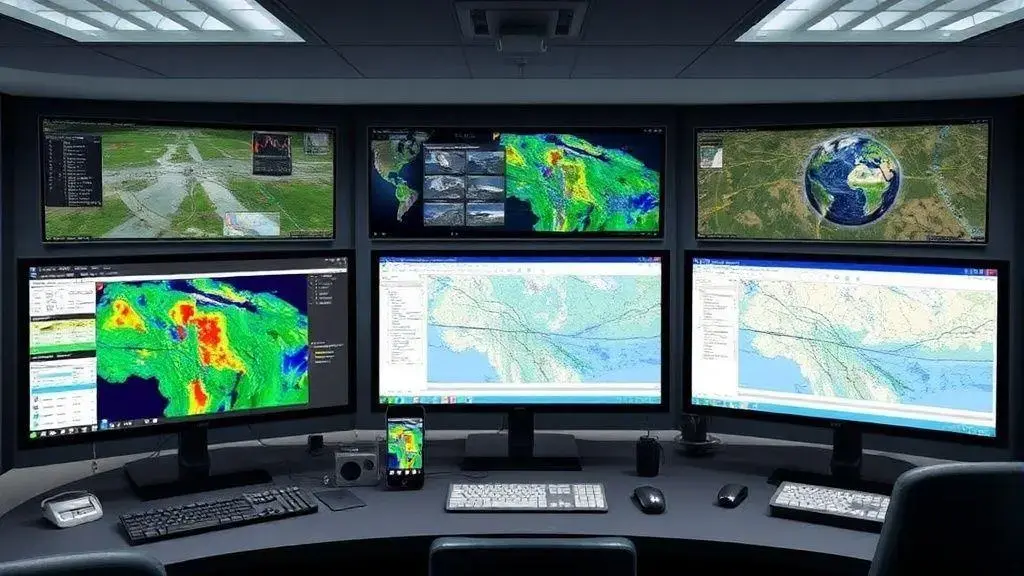Cloudburst flood warning systems: what you need to know

Cloudburst flood warning systems utilize advanced technologies and community preparedness strategies to provide timely alerts and enhance safety during sudden flooding events.
Cloudburst flood warning systems are crucial for protecting lives and property during extreme weather events. Have you ever wondered how these systems work and why they’re important? In this article, we’ll dive into their functions and benefits.
Understanding cloudburst events
Understanding how cloudburst events occur is essential for developing effective flood warning systems. Cloudbursts happen when a significant amount of rain falls in a short time. This can lead to sudden and intense flooding, which poses serious risks to safety and infrastructure.
What causes cloudbursts?
Cloudbursts are typically caused by specific weather patterns. These can include temperature changes, humidity, and topography. For example, mountains can trap moist air, leading to extreme rainfall.
Characteristics of cloudburst events
These events are characterized by:
- Heavy rainfall exceeding 100 mm per hour
- Localized flooding that can overwhelm drainage systems
- Quick onset, often with little to no warning
- Possible landslides in hilly areas due to saturated soil
The sudden nature of cloudbursts can make them particularly hazardous. Understanding these events helps communities prepare and respond effectively. For instance, areas with a history of heavy rains should have measures in place to warn residents and protect sensitive infrastructure.
Moreover, technologies such as radar and satellite imagery can aid in forecasting these events. By analyzing weather patterns, meteorologists can identify the potential for a cloudburst, allowing for timely alerts to be issued. These warnings can make a huge difference in saving lives and minimizing damage.
In summary, recognizing the dynamics of cloudburst events plays a critical role in flood prevention. With the right tools and information, communities can enhance their safety and resilience.
How cloudburst flood warning systems operate
Understanding how cloudburst flood warning systems operate is crucial for effective disaster management. These systems are designed to detect and forecast sudden rainfall events that can lead to flooding.
Key Components of the System
Cloudburst flood warning systems rely on several key components. These include:
- Rainfall data collection through weather stations
- Advanced modeling software to predict potential rain patterns
- Real-time data communications to inform the public
- Emergency response protocols to ensure quick action
Each component works together to enhance the reliability of forecasts. For instance, rainfall data is collected from various sources to provide accurate and timely information. This data is then analyzed using advanced algorithms to predict where and when heavy rains might occur.
Real-Time Monitoring
Real-time monitoring is a crucial aspect of these systems. Sensors are deployed in high-risk areas to detect rainfall intensity. When thresholds are exceeded, alerts can be sent out to residents and local authorities.
This quick response is essential. By issuing warnings, communities can prepare for possible evacuations or take other safety measures. The effectiveness of cloudburst flood warning systems lies not just in detection but in the speed of communication.
Moreover, many systems are integrated with smartphone apps and online platforms. This provides users with immediate access to critical information. As a result, awareness is increased, and people know how to respond during an emergency.
In addition to technology, collaboration with meteorological services enhances the accuracy of predictions. By using satellite data, meteorologists gain insights into developing weather patterns, allowing for better forecasting and timely alerts.
Overall, the collaboration between technology, data, and community preparedness is the backbone of how cloudburst flood warning systems operate.
Key technologies used in flood forecasting

Exploring the key technologies used in flood forecasting reveals how advanced tools and methods can protect communities. These technologies are vital in predicting potential flooding events and ensuring timely alerts.
Advanced Weather Radar
One of the primary technologies in flood forecasting is advanced weather radar. This system provides real-time data on storm systems. The radar helps track rainfall intensity and movement, which is essential for accurate predictions.
Hydrological Models
Hydrological models simulate how water moves through the environment. These models integrate various factors, including precipitation, soil type, and land use. By understanding how water flows, scientists can predict how much rain will lead to flooding.
- Types of hydrological models include:
- Event-based models for short-term predictions
- Continuous models for long-term assessments
- Distributed models that consider topography and land use
These models help emergency responders prepare for weather events by providing scenarios based on different rainfall amounts.
Remote Sensing Technology
Remote sensing technology, such as satellite imagery, plays a crucial role. Satellites collect information about large-scale weather patterns and surface conditions. This data aids in understanding regional weather trends, enhancing forecasting capabilities.
Many flood forecasting systems also use Geographic Information Systems (GIS). GIS allows for efficient mapping of flood-prone areas, helping communities visualize the risks associated with heavy rainfall.
Communication tools are equally important. Mobile apps and alert systems keep residents informed of impending floods. These alerts are based on the data collected from the aforementioned technologies. The combination of technologies ensures quick responses to potential flooding threats.
In short, the integration of various advanced technologies in flood forecasting enhances the ability of communities to prepare for and respond to flooding. These technologies are essential in building resilience against extreme weather.
Case studies of successful flood warnings
Examining case studies of successful flood warnings helps illustrate the effectiveness of flood warning systems. These real-world examples show how timely alerts can save lives and reduce damage.
Case Study: 2014 Washington State Flood
In 2014, Washington experienced significant flooding after heavy rain. The National Weather Service issued timely warnings based on data from advanced weather radar and hydrological models. Residents received alerts via mobile apps and local news. As a result, many families evacuated before the floodwaters rose, demonstrating the importance of quick communication.
Case Study: The 2015 Chennai Floods
In Chennai, India, severe flooding occurred following heavy rainfall in November 2015. The Indian Meteorological Department utilized technology to issue warnings ahead of time. Community efforts focused on disseminating this information through social media and local broadcasters. Many residents were able to prepare by moving valuables and securing their properties, reducing the impact of the flooding.
Key Lessons Learned
Successful flood warning cases show several key lessons:
- Timely communication is crucial for effective response.
- Community engagement helps increase awareness and preparedness.
- Technology enhances the accuracy of forecasts and alerts.
- Collaboration between organizations can improve response times.
By analyzing these case studies, we can see that when communities are well-informed and prepared, the effects of flooding can be mitigated. This highlights the importance of investing in flood warning systems and technologies that support timely alerts.
The powerful combination of technology, timely warnings, and effective communication saves lives during flooding emergencies. Every successful case reinforces the need for strong partnerships within communities to promote safety and preparedness.
Best practices for communities
Implementing best practices for communities is essential to enhance the effectiveness of flood warning systems. These practices help ensure that residents are prepared and can respond quickly during emergencies.
Community Education and Awareness
Educating the community about flood risks is critical. Providing information through workshops and informational materials helps residents understand the importance of flood preparedness. Knowledge about local flood history and potential hazards can empower individuals to take action.
Developing Emergency Plans
Communities should create comprehensive emergency plans. These plans should include:
- Evacuation routes and procedures
- Designated safe zones for residents
- Emergency contact lists
- Regular drills to practice responses
Having a well-structured emergency plan ensures a swift and organized response when a flood warning is issued.
Enhancing Communication Channels
Clear communication is vital during a flood event. Communities should establish multiple channels for disseminating information. These can include text alerts, social media updates, and public announcements in local areas. The goal is to reach as many people as possible, ensuring that everyone is informed about current conditions and safety measures.
Moreover, collaborating with local organizations, schools, and businesses can amplify messages and increase community engagement. When residents actively participate in safety programs, they become more resilient to flooding.
Engaging in Local Partnerships
Collaboration among community members, government agencies, and non-profits strengthens flood preparedness efforts. Forming partnerships allows for resource sharing and coordination of response efforts. In emergencies, having established relationships can facilitate quicker responses and more efficient resource allocation.
Finally, regularly evaluating and updating flood response plans based on experiences and changing conditions ensures that communities remain proactive. The collective effort of understanding risks, preparing plans, and improving communication contributes significantly to community resilience against flooding.
FAQ – Frequently Asked Questions about Cloudburst Flood Warning Systems
What is a cloudburst?
A cloudburst is a sudden and intense rainfall event that can lead to flash flooding, often occurring in specific geographic areas.
How can communities prepare for flooding?
Communities can prepare by educating residents, developing emergency plans, and establishing clear communication channels for alerts.
What technologies are used in flood forecasting?
Key technologies include advanced weather radar, hydrological models, and remote sensing, which help predict rainfall and flooding events.
Why is community engagement important in flood preparedness?
Engagement helps ensure that residents are informed and can respond quickly, increasing overall safety and resilience during a flood event.





